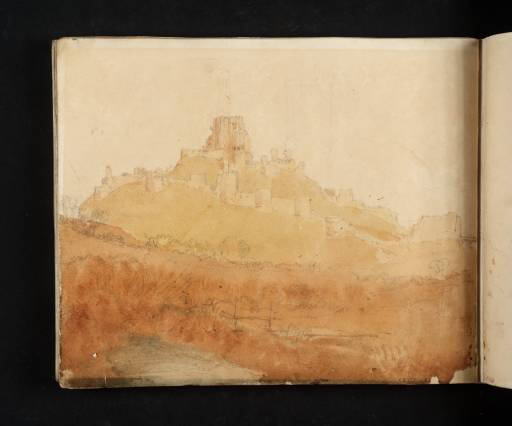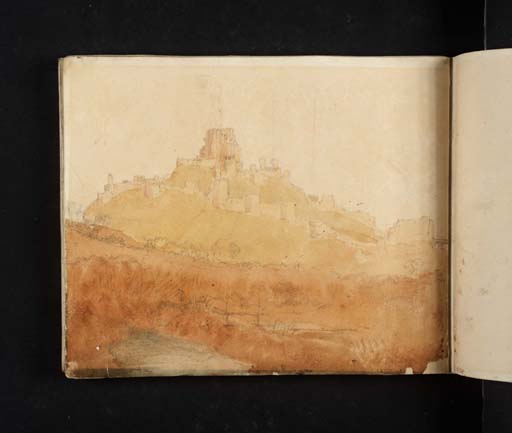Joseph Mallord William Turner Corfe Castle from the South-West 1811
Image 1 of 2
Joseph Mallord William Turner,
Corfe Castle from the South-West
1811
Joseph Mallord William Turner 1775–1851
Folio 8 Recto:
Corfe Castle from the South-West 1811
D08815
Turner Bequest CXXIV 8
Turner Bequest CXXIV 8
Pencil and watercolour on white wove paper, 170 x 209 mm
Blind-stamped with Turner Bequest monogram bottom centre
Stamped in black ‘CXXIV – 8’ bottom right
Blind-stamped with Turner Bequest monogram bottom centre
Stamped in black ‘CXXIV – 8’ bottom right
Accepted by the nation as part of the Turner Bequest 1856
Exhibition history
1896
Fifth Loan Collection, National Gallery, London, 1896, Grosvenor Museum, Chester, 1897–9, Corporation Galleries, Glasgow, 1900–2, National Gallery, London, 1903, Museum and Art Gallery, Bristol, 1904–6, National Gallery, London, 1907–8, Liverpool Art Gallery, 1909–10, Aberdeen, 1911, Nottingham Art Gallery, 1912, Grosvenor Museum, Chester, 1913, Museum and Art Gallery, Plymouth, February 1914, Blackpool, 1915, Blackburn Art Gallery, 1916–18, Bradford Art Gallery, 1919–20, Burnley, 1921–2, Colne, 1923–4, Rawtenstall, 1925–6, Tate Gallery, London, 1927–30, transferred to the British Museum, London, 1931 (no catalogue but numbered 29, as ‘Dunstanborough Castle’)
References
1909
A.J. Finberg, A Complete Inventory of the Drawings of the Turner Bequest, London 1909, vol.I, p.353, CXXIV 8, as ‘Corfe Castle’.
1988
Evelyn Joll, ‘Turner at Dunstanborough’, Turner Studies, vol.8, no.2, Winter 1988, p.6.
The castle is seen to the north-east across low ground; the village is visible from this angle but lies beyond the edge of the composition to the right. The viewpoint is from near the present footpath north of the stream running through the shallow, marshy valley between West Street and the Church Knowle road below West Hill. A wooden structure indicated in the foreground is probably a rough footbridge across the marsh. A view from a similar angle but from a greater distance is on folio 16 verso (D08824). For other drawings of the castle and village, see the entry for folio 17 recto (D08826).
The spurious former identification of the subject as Dunstanburgh Castle presumably arose from the general similarity of the composition to Turner’s various views of that building, for example the wash study for his Liber Studiorum engraving (Tate D08118; Turner Bequest CXVI Q). Conversely, at least one Dunstanburgh painting was sold as a view of Corfe even during Turner’s lifetime.1
Technical notes:
Like the view on folio 7 recto (D08814), the pencil drawing has been reinforced by rough brown washes. The pale stone of the fortifications is differentiated from the castle’s mound, with shadows washed in on the west sides of the towers to suggest morning light. A stretch of water has been washed in below in blue or grey (Finberg notes: ‘blue faded’). The paper is browned from prolonged display, while the pigments in general have faded. The edges formerly protected by a display mount are bright where the paper is bare, and the watercolour retains its original strength along the bottom edge. Losses to the bottom right corner have been made good with blank paper, which stands out against the watercolour.
Verso:
Blank, save for inscriptions: inscribed by John Ruskin in red ink ‘41’ top right; inscribed in pencil ‘45’ ascending diagonally at top left; and in pencil ‘Corfe. | CXXIV . 8(?)’ bottom right.
Matthew Imms
February 2011
How to cite
Matthew Imms, ‘Corfe Castle from the South-West 1811 by Joseph Mallord William Turner’, catalogue entry, February 2011, in David Blayney Brown (ed.), J.M.W. Turner: Sketchbooks, Drawings and Watercolours, Tate Research Publication, December 2012, https://www


